The recent British Shooting Show has come and gone and I thoroughly enjoyed my time there. I met with various manufacturers and distributors, checked out the new range of X200 rifles from Air Arms, the RTI airguns from Highland Outdoors, and of course spoke with so many readers and followers of the Shooting & Country TV hunting series.
You may remember me using the RTI P3 recently, and I can honestly say I was blown away with the performance, so when my old mate, Ryan Charlton, at Highland offered me the chance to try out the new prototype Mora from RTI, I snapped his hand off. I had the chance to talk with Rok from RTI and handle the Mora, and everything screamed quality and innovation. I really couldn’t wait to get to grips with it in the real world ... in the woods and fields.
Apparently, I would have the honour of being the first in the UK to use it in anger, and the following week I was like a kid at Christmas sitting by the window looking for Santa. No sled or reindeers were involved with the delivery, but there was a red-suited postman with a beard ... that’ll do for me!
SCOPE AND MOUNTS
I spent a bit of time with Jamie at Hawke Optics at the BSS and I’d ordered myself the Vantage 4-16 x 50 SF30 for the very purpose of being my test scope for the various airguns that come my way for reviewing. The Vantage is a pretty damn good scope at a great price and the glass is far better than the cost would suggest.
Mounts for the scope are Tac-Rings provided by Tier-One. They need to be high because the lows and mediums had my head way too low. The quality of these British-made hoops is undeniable, and the four-screw tops hold the scope secure and firm. Tier-One also provided the bipod in the shape of the carbon-fibre tactical with Picatinny attachment. This bipod is solid as a rock and oozes quality, steadiness and durability, and the legs lock into position with just a press of the top buttons, or with a sharp pull of the legs. Machined from a solid billet of aerospace aluminium, I would say you’d struggle to find better bipods. The commitment to provide top quality accessories and equipment can be seen through the investment made in the CNC technology with tolerances to die for.
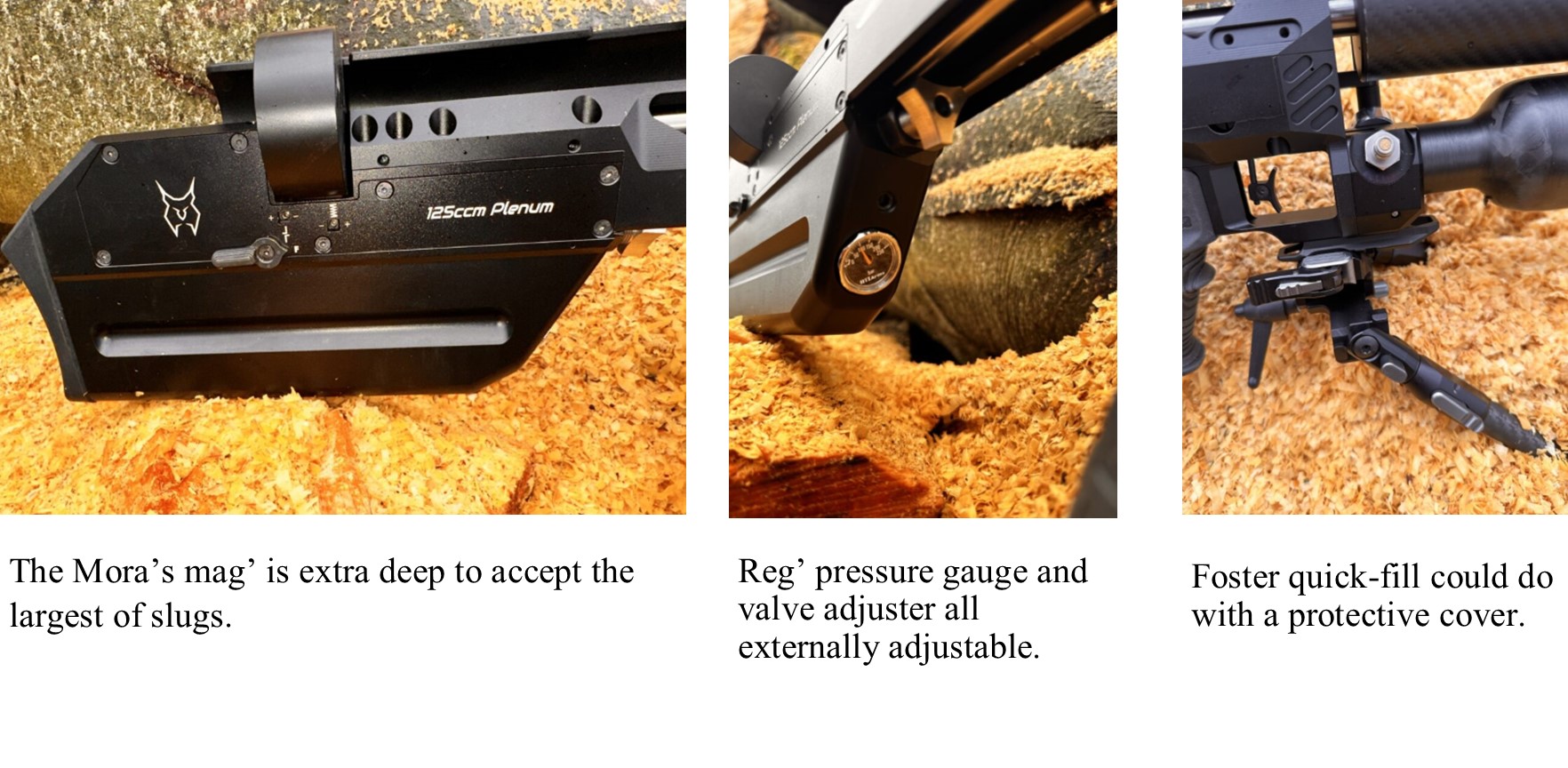
PROTOTYPE ISSUES
The .22 calibre Mora turned up well before the scope, mounts and bipod, which was just as well. The RTI prototype was the very one that had been on display at the BSS, and that itself brought a few issues; many people had played with the Mora over the three days, screws has been undone or tightened, some had come loose through the endless toying, and some had been intentionally loosened to relieve the Mora of air for the show.
Now, I am going to be totally honest here – I am no gun tuner. I can do my bit, but I believe in courses for horses, and if the job requires the expertise of an expert, then so be it, but after tightening screws and watching the limited amount of videos available I was confident I could get the Mora to a place where I would be happy.
This superb airgun was made to be high power, so once the 700cc bottle had been filled, the reg’ pressure was set to 100 bar, which seemed a good starting point and was easily done externally with a 6mm Allen key. The pressure can be seen rising on the reg’ gauge, and once the 100 bar had been reached it was time to concentrate on the valve adjustments. With the thumb screw fully turned in, the power and speed was low – too low – so slow, precise anticlockwise adjustments with three shots taken between the adjustments was the plan. Unfortunately, my basic Combro CB-625 wasn’t up to the job, so I sent for a LMBR R2A chronograph, which duly arrived two days later. This is a superb piece of equipment and I now wonder why I didn’t get the LMBR earlier.
I set the Mora on a sandbag rest, resulting in an 8-shot string with a 36 ft.lbs. average, a deviation of .26 ft.lbs. and fps in the mid to high 950s, with 18gr Air Arms Diablo Fields ... happy? I was delirious!
The Mora is said to be capable of 90 ft.lbs. in .22, and that is something I’d like to explore at a later date, but for now the 18s would suffice; the consistency of the rifle should transfer into accuracy, and my delirium would turn into ecstasy.
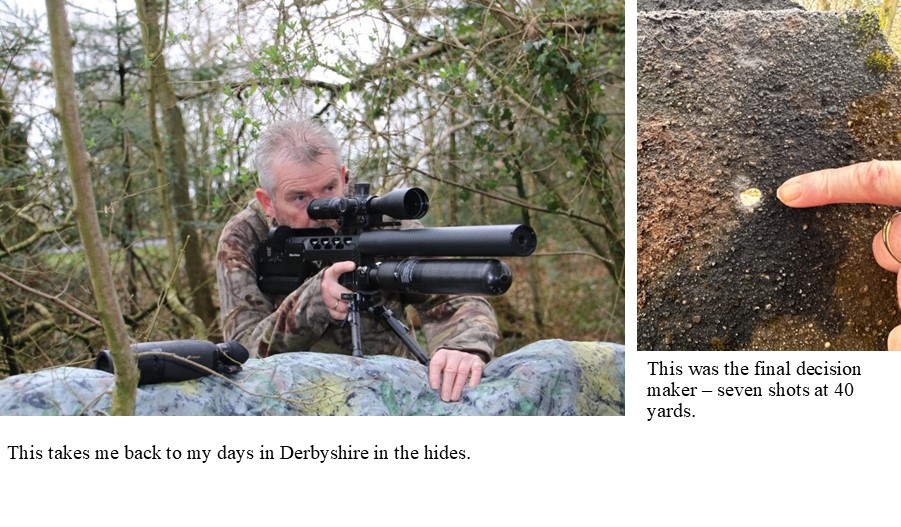
ACCURACY TESTING
The next day, the scope, mounts and bipod turned up and the build began. I recalled a conversation with Ryan and Rok when I was told that in the rush to get the Mora to the show, the Picatinny rails had been forgotten. There is a forward-mounted one in the usual position, just in front of the trigger, plus there’s the facility to mount an additional one under the rear of the stock, for rear supports etc. Luckily, I had a spare short Pic’ rail with the M-Lok fitting screws. Just bear in mind that it’s the smaller screws that are needed to attach any M-Lok attachments, not the larger ones.
Accuracy testing was next on the agenda, and the perfect place was on one of my permissions where a JCB was parked. It provided a superb, rock-steady platform to shoot from, and my target was a roofing tile rescued from the rubble used to form the track through the wood. I set it out at 40 yards and my first shot was high by about 7 inches, but perfectly in line on elevation. A handful of clicks had me on point, and this amazing rifle put the next seven pellets through the same hole, smaller than my little finger nail. This was the decider for me, and that evening, I was on the phone to Ryan at Highland with instructions – ‘Get me one!’
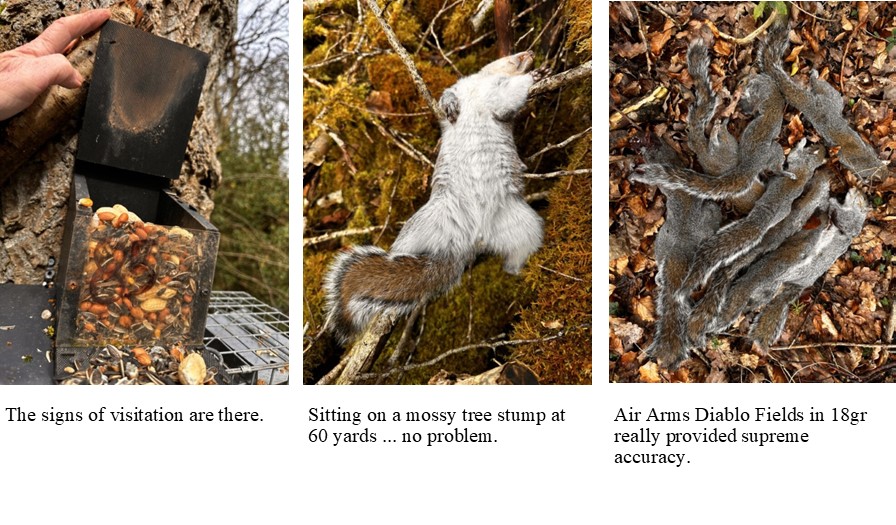
BACK IN TIME
It was now show-time and I had just the place to put the Mora through its paces. My trail cameras were reporting a few greys now coming into the feeders. I knew they were around, but hesitant to come to my offerings. Usually, they turn up in numbers around April to May, but they were early this year – good for me, bad for them. The place in question is a small, triangular wood, bordered on two sides by roads, and farm fields on the other. It is serviced by a single feeder and a trap, left unset at this time because reds have been picked up by the trail cam. I could shoot from the truck because I could park on the land, but there was a fallen tree that was offering great cover and support, plus it gave me a chance to use a giant poncho as a hide, given to me by another mate, Mark Foster, so a big shout out to him. It was like going back to my days in Derbyshire, when I sat in hides waiting for the skinnies to turn up. It’s such a simple approach and extremely productive when the greys are in full feeding mode. I had identified six different greys and was looking to get them all – even if it took all day.
I was in the hide by 6am and scanning the wood fervently with the Gemini thermal binoculars. There were way too many pheasants around, and songbirds were all over the ground on the loose feed, but the unmistakeable image of a grey coming down a spruce tree, closely followed by another, indicated the start of the action. There was no hesitation from the greys as they competed for position at the top table. Once the pecking order had been established, one on the feeder and one on the ground, it was time. I took aim at the ground-borne skinny first, and dropped it on the spot then aligned the Vantage crosshairs on the upper grey as it looked down at its motionless buddy. The second skinny soon joined it and the scanning continued.
NECESSARY THERMAL
The use of thermal in these situations is an absolute must because I could see deep into the wood and high up into the treetops. There was a couple chasing each other around at over 80 yards, but even with the 36 ft.lbs. power of the Mora, there was too much brash and undergrowth to compete with, but they’d come in eventually. They did, but not before I took another couple from the upper reaches of the spruces. It appeared that they had been on the feed before I got there because they both had monkey nuts in their clutches. I was getting impatient waiting for the two playful ones, and it looked like they were edging closer by the minute, but at 60 yards, they stalled again and resumed their playtime.
Every now and then, they would pause as if catching their breath, and this was my opportunity to take them down. The first perched itself on a moss-covered tree stump, whilst the other sat on a branch above it, having a scratch. The same method of operation was engaged and I took the lower one first with a heart/lung shot, which dropped it stone dead immediately. I thought I’d lost the upper one because it had gone from its previous position, but it had only moved up a couple of branches, and if anything, it gave me an even clearer shot – the 18gr Diablo could be heard cracking into its skull, even from where I was positioned.
I had the six and was happy to stay a while longer, but after an hour I was ready to move on and my movements must have alerted another couple of skinnies which had been out of sight. This can be the problem when shooting statically from a hide or cover. If they are on alert, they clamp to the tree trunk or hunker down in a fork and generally out of sight, but once seen it’s only a matter of patience before you’ll get the crosshairs on them, and true to form, that’s exactly what happened. I had been yhere four hours and taken eight, which is very satisfying, but concerning at the same time. These sort of numbers are worrying, especially in an area where reds are seen.
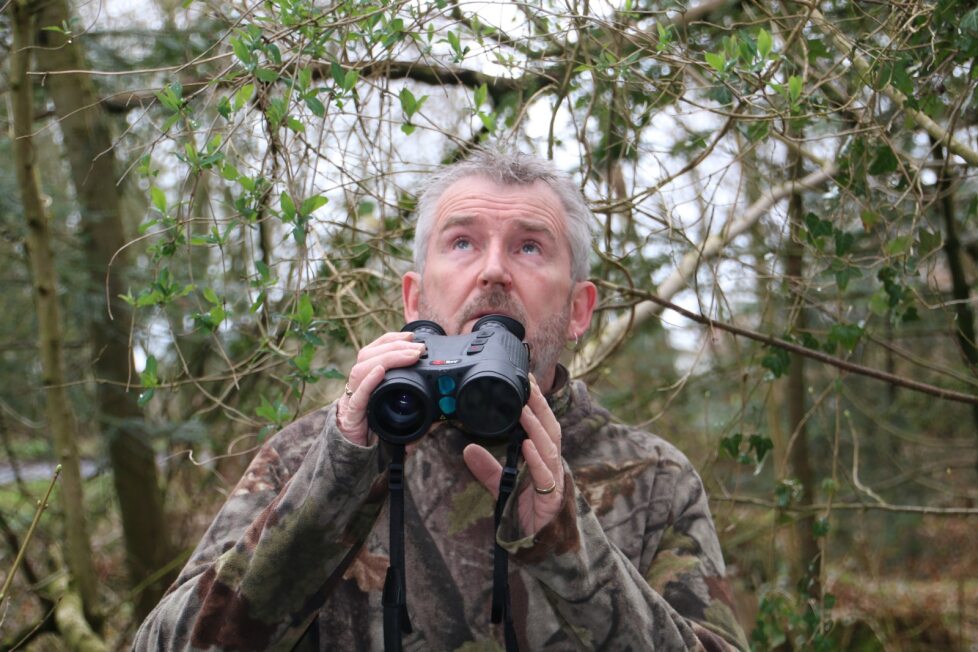 Scan, scan and scan again ... they are out there.
Scan, scan and scan again ... they are out there.
TWO FOR JOY
On the way to my next wood I had a call from a local lady who had witnessed a pair of magpies chasing a red squirrel. She seemed to think that the red was carrying a very young kitten, which could be a bit early, but wasn’t beyond possible. I arranged to call in and discuss the possibility of putting a Larsen trap out, but found that it wouldn’t be needed because the magpies were still hanging around.
The garden was huge, stretching well over 250 yards in length and maybe 150 yards wide – it was more like a stately home. Anyway, it was quite obvious that these corvids were on the hunt for something – not on my watch, sonny Jim! A garden shed was perfectly placed for cover and position and this was the easiest pair of magpies I have ever taken – both at 65 yards and probably preoccupied with hunting out an easy meal.
This RTU Arms Mora performed supremely all day, and gave me the best first day for a new gun in the field – and yes, I will definitely be getting one.
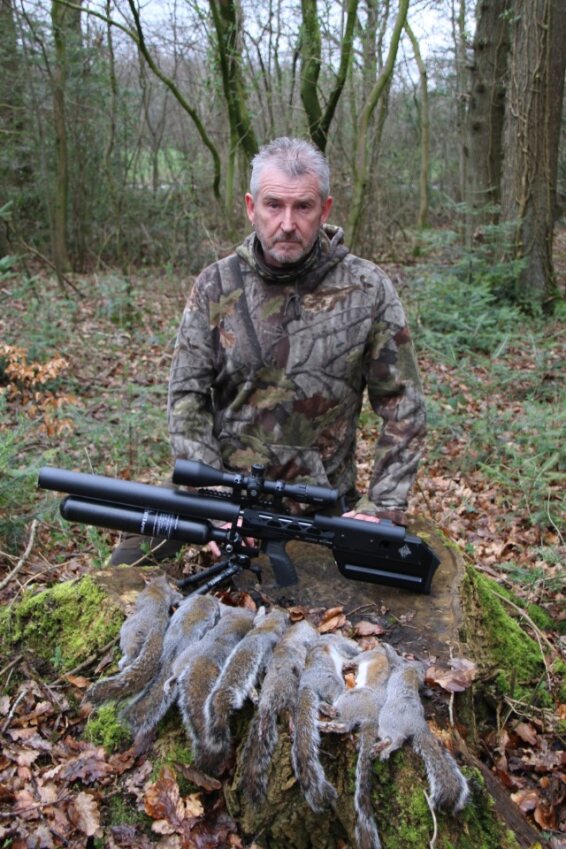 Definitely Mor-A this, please.
Definitely Mor-A this, please.